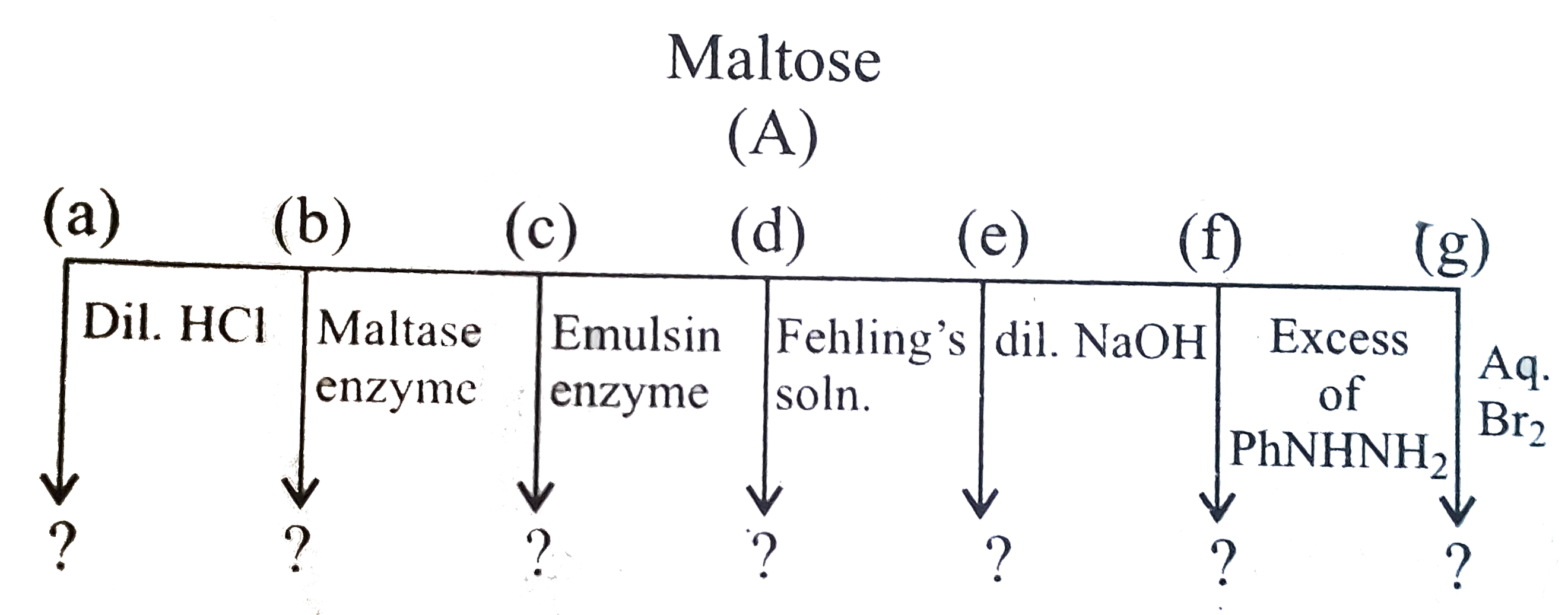Complete Solutions to Illustration of chapter BIOMOLECULES of Class 12 book with complete answers and questions
| Class 12 | CHEMISTRY |
| Chapter | BIOMOLECULES |
| CENGAGE CHEMISTRY | Illustration |
| Number Of Questions | 20 |
| Academic Year | 2023-24 |
Distinguish between `alpha-D`-gluecop-yranose `(I)` and methyl `alpha-D`-gluocopyranoside `(II)`.
03:38View SolutionWrite the structures obtained by the epimerisation of `alpha-D`-gluocose at `C-2,C-3`, and `C-4(OH)` groups.
03:07View SolutionExplain, in neutral or basic aqueous solution, glycosides do not show mutarotation, but in acidic medium they show mutarotation.
03:03View SolutionComplete the following reactions:
(a). `OCH-(CHOH)_(4)CH_(2)Ohunderset(5HIO_(4))(rarr)`
(b). `HOCH_(2)-overset(O)overset(||)(C )-(CHOH)_(3)-CH_(2)Ohoverset(5HIO_(4))(rarr)`
(c ).`O=HC-underset(O)underset(||)(C)-underset(("Onsone"))((CHOH)_(3)CH_(2)OH)overset(zn//ACOH)(rarr)`05:10View Solution(a). Glucose and fructose form the same osazone, what does it prove?
(b). Why more than `3mol "of"PhNHNH_(2)` do not react with glucose and fructose and how does `PhNHNH_(2),` which is a powerful reducting agent, act as an oxidising agent in this case?09:20View SolutionComplete the following reactions
 05:02View Solution
05:02View Solution(a). Why is `beta-D-`gllucopyranose the most abundant of naturally occurring aldohexoses?
(b). Write the most stable chair conformer for `alpha-D-` fructopyranose. How does it dirrer from `beta-`anomer?View Solution(a). What is the average molecular mass of starch?
(b). What is the approximate average number of glucose units in the sample of starch?
`(Given: 20 gm L^(-1)` of starch has an osmotic pressure `=10^(-2) atm at 25^(@)C.)`03:58View SolutionThe specific rotation of `alpha-`glucose is `+112^(@)` and `beta-`glucose is `+19^(@)` and the specific rotation of the constant equilibrium mixture is `+52.7^(@)`. Calculate the percentage composition of anomers `(alpha and beta)` in the equilibrium mixture.
03:05View SolutionGive the steps for the conversion of `D-`glucose to `D-`fructose and vice versa.
03:24View SolutionExplain why aldoses react with bendict's solution and `PhNHNH_(2)`, but not with `NaHSO_(3)`.
03:31View SolutionA tripeptide oon complete hydrolysis gives glycine, alanine, and phenylanine,using three-letter symbols write down the possible sequences of the tripeptide.
02:19View SolutionA dipetide on hydrolysis gives two amino acids.
`(A)NH_(2)underset(R )underset(|)(C )HCOOH and (B)H_(2)Nunderset(R')underset(|)(C )HCOOH`
The dipetide is also hydrolyses by leucine amino peptidase enzyme giving amino acid `(B)`. What is the structure of dipeptide?View SolutionA tripeptide `(X)` on hydrolysis gives three amino acids `(A)(NH_(2)-underset(R )underset(|)(C )H-COOH)`,
`(B)(NH_(2)-underset(R ')underset(|)(C )H-COOH),` and
`(C )(NH_(2)-underset(R ')underset(|)(C )H-COOH).(X)` and reaction with `NH_(2)NH_(2)` gives a dipeptide `(Y)` and amino acid `(B)`.
The dipeptide `(Y)` is hydrolysed by carboxypeptidase enzyme and gives amino acid `(A)`. what is the structure of `(X)`?View SolutionThe two samples of `DNA,` `A` and `B` have melting tempreatures `(T_(m)) 340` and `350 K`,respectively. Can you draw any conclusion from this data regarding their base content?
02:34View SolutionIn `E. coli DNA,` `AT//GC` ratio is `0.93`. If the nimber of moles of adenine in its `DNA` sample is `465,000,` calculate the number of moles of guanine present.
01:57View SolutionOne strand of a `DNA` has the sequence `ATGCTTCA`. What is the sequence of the bases in the complementary strand?
02:22View SolutionWhat will be the sequence of bases on `mRNA` molecule synthesised on the `DNA` strand, `TATCTAC TGGA`?
02:44View SolutionAn unsaturated fatty acid on ozonolysis yields one aldehyde `H_(3)C(CH_(2))_(7)CHO` and an aldehyde monocarboxylic acid `OHC(CH_(2))_(7)COOH`. Write down the structure and name of the acid.
03:37View SolutionOne mole of a naturally occurring fat on hydrolysis with `NaOH` gave `1 mol` of glycerol together with sodium palmitate and sodium stearate in `1:2` molar ratio. The molecule of the fat is symmetric. Write down the struceture of the fat.
03:31View Solution
Illustration questions and complete solutions for chapter BIOMOLECULES of CENGAGE CHEMISTRY (HINGLISH) of Class 12
All Exercises from CENGAGE CHEMISTRY Class 12 CHEMISTRY BIOMOLECULES
- Exercises (Assertion-Reasoning)
- Exercises (Concept Application)
- Exercises (Linked Comprehension)
- Exercises (Multiple Correcttype)
- Exercises (Single Correcttype)
- Exercises Archives (Analytical And Descriptive)
- Exercises Archives (Assertion-Reasoning)
- Exercises Archives (Single Correct )
- Illustration
- Solved Examples
